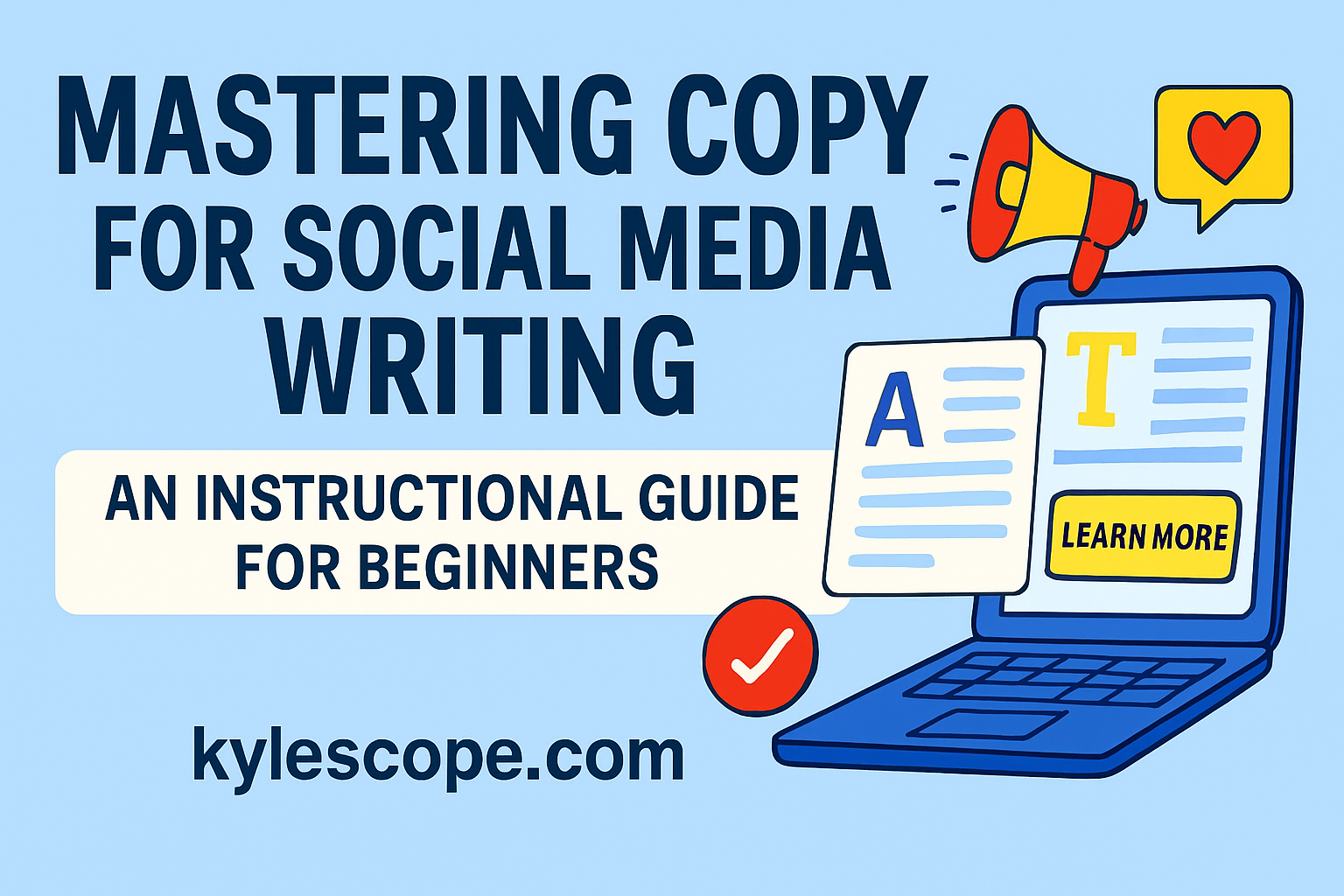
Introduction: Why Copy Shapes Digital Communication
Copy is more than words on a screen. It is the structured, intentional use of language to persuade, inform, and guide readers toward a specific action. In the digital age, where attention spans are shrinking and competition for visibility is intensifying, the ability to craft compelling writing determines whether a message resonates or falls short. Beginners in social media writing often confuse casual posting with strategic communication, but the difference lies in the deliberate design of persuasive language.
This guide draws from foundational principles outlined in Copywriting 101: How to Craft Compelling Copy and adapts them for social media beginners. It provides a structured, academic-style exploration of what copy is, why it matters, and how to apply proven techniques. Each section builds on the last, ensuring that readers not only understand the theory but also gain practical strategies for implementation.
What Is Copy in Marketing?
Copy in marketing refers to written communication designed to persuade, inform, or convert. Unlike general writing, which may entertain or educate without a specific outcome, copy always aims to drive a particular action. That action may be a purchase, a subscription, a share, or even a simple click. The defining characteristic is intent: every sentence exists to move the reader closer to a decision.
General writing, such as essays or journalistic articles, prioritizes clarity and information delivery—copy, however, layers persuasion into its structure. For example, a news article may describe a product launch, while marketing copy for the same product highlights benefits, urgency, and reasons to act. This distinction is vital because beginners often assume that good grammar and clear sentences are sufficient. In reality, persuasive writing requires strategy, psychology, and structure.
Types of Copy That Drive Results
Different types of copy serve other purposes, and understanding these categories helps beginners choose the right approach for social media.
- Sales-focused writing: This form emphasizes persuasion and often appears in product descriptions, advertisements, or promotional posts. It highlights benefits, addresses objections, and leads directly to a call to action.
- Landing page writing: This type focuses on conversion. Every element, from the headline to the closing statement, exists to guide the visitor toward a single action, such as signing up or making a purchase.
- Email writing: Emails combine personalization with persuasion. They nurture relationships, build trust, and encourage readers to take incremental steps toward a larger goal.
Each type requires a slightly different tone and structure, but all share the principle that every sentence must lead to the next. As Joe Sugarman emphasized, the purpose of a headline is to get the first sentence read, and the purpose of the first sentence is to get the second sentence read. This cascading effect applies across all formats.
Why Great Copy Matters
Excellent copy matters because it directly influences conversion rates, brand voice, and search visibility. A well-crafted message can transform a casual browser into a loyal customer. Poorly structured writing, on the other hand, results in lost opportunities and wasted resources.
Conversion rates depend on clarity, persuasion, and emotional resonance. A headline that promises a clear benefit increases the likelihood of engagement. A body paragraph that demonstrates credibility through the use of statistics or testimonials builds trust. A closing statement that reduces risk through guarantees encourages action. Together, these elements create measurable results.
Brand voice also depends on consistent, persuasive writing. Social media audiences expect authenticity, and copy that reflects a brand’s values strengthens recognition. Furthermore, search engines reward clear, benefit-driven writing. An optimized copy that integrates keywords naturally improves visibility, making it easier for audiences to find and engage with content. For advanced strategies, resources like SEO-focused writing services provide structured approaches to aligning persuasive language with search performance.
How to Write Effective Copy
Writing compelling copy requires a balance of structure and creativity. Beginners benefit from proven formulas such as AIDA (Attention, Interest, Desire, Action) and PAS (Problem, Agitation, Solution). These frameworks ensure that writing flows logically and persuasively.
- AIDA: Start with a headline that captures attention, follow with content that builds interest, highlight benefits that create desire, and conclude with a clear call-to-action.
- PAS: Identify a problem, amplify the frustration it causes, and present your product or service as the solution.
Tone also matters. Social media audiences respond to conversational, clear, and concise language. Overly complex sentences or jargon alienate readers. Instead, writers should use simple words, short paragraphs, and active verbs. As the Copywriting 101 text emphasizes, clarity always wins. Beginners can refine their skills by practicing with outlines, revising drafts multiple times, and studying examples of high-performing posts. For structured guidance, platforms like Kylescope’s writing resources offer practical frameworks.
Copy vs. Content: What’s the Difference?
Copy and content often overlap, but they serve distinct purposes. Content informs, educates, or entertains, while copy persuades. A blog post about fitness trends is content, but the section that encourages readers to sign up for a training program is copy. Both are valuable, but they require different approaches.
Beginners in social media writing must learn to strike a balance between the two—too much content without persuasive elements results in engagement without conversion. Too much copy without valuable content can feel pushy and erode trust. The most effective strategies integrate both, offering helpful information while guiding readers toward action. For example, a tutorial on social media design may include tips (content) alongside a call-to-action for professional copy editing services. This balance ensures that audiences receive value while businesses achieve measurable outcomes.
Examples of High-Converting Copy
Real-world examples demonstrate how persuasive writing is applied in practice. Consider the famous Rolls-Royce advertisement by David Ogilvy: “At 60 miles an hour, the loudest noise in this new Rolls-Royce comes from the electric clock.” This sentence captures attention, conveys a benefit, and positions the product as superior.
Another example is Domino’s Pizza’s guarantee: “30 minutes or less, or it’s free.” This statement addresses urgency, reduces risk, and creates a compelling reason to choose Domino’s over competitors. Both examples demonstrate the principle that clarity and specificity outperform vague promises.
For beginners, analyzing such examples provides insight into structure and tone. Social media posts that highlight specific benefits, use numbers, or include guarantees often outperform generic statements. Beginners can study curated examples through resources like Kylescope’s copywriting services to see how professional writers adapt principles to modern platforms.
Structuring Copy for Social Media Beginners
Social media writing requires brevity without sacrificing persuasion. Beginners should focus on three key elements: headlines, body text, and calls to action. Headlines must grab attention immediately, often by promising a benefit or sparking curiosity. Body text should expand on the promise with clarity and proof. Calls-to-action must be explicit, guiding readers toward the next step.
Bullet points, short paragraphs, and a conversational tone enhance readability. For example, a post promoting a webinar might use the following structure:
- Headline: “Learn How to Double Your Engagement in 30 Days”
- Body: “Discover proven strategies that leading brands use to grow audiences. Join us for a free session packed with actionable insights.”
- Call to action: “Reserve your spot today.”
This structure ensures that even skimmers understand the value and the action required. Beginners who practice this approach consistently will see measurable improvements in engagement and conversions.
Advanced Insights for Beginners
While beginners should master fundamentals, they also benefit from advanced insights. Research indicates that emotional triggers, storytelling, and social proof can significantly enhance persuasion. For example, testimonials in headlines provide credibility, while stories create a sense of relatability.
Additionally, testing remains essential. Even the most experienced writers cannot predict with certainty which headline or call-to-action will perform best. Beginners should adopt a mindset of experimentation, using analytics to refine their approach. Over time, this iterative process leads to mastery. For further exploration, external resources such as HubSpot’s guide to copywriting provide additional frameworks and examples.
Conclusion: Building a Foundation for Persuasive Writing
Copy is the foundation of persuasive marketing communication. Beginners who understand its principles, study proven examples, and practice consistently will develop skills that extend beyond social media. The ability to persuade through language influences not only marketing outcomes but also leadership, education, and personal communication.
For those ready to take the next step, professional support accelerates progress. Beginners and businesses alike can benefit from expert copywriting services that refine messaging, optimize for search, and ensure clarity. Whether you are crafting your first social media post or scaling a brand, investing in persuasive writing skills delivers long-term results.
